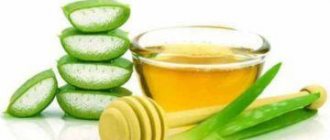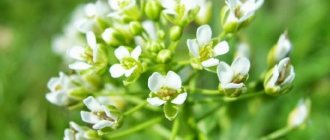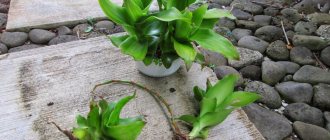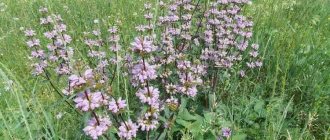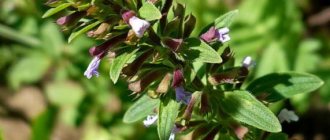Description of the plant
Aloe is an unpretentious perennial with fleshy green sword-shaped leaves. The leaves form a large rosette or are located on a thick trunk (aloe arborescens). Along the edges of the leaf blade there are small sharp spines, with the help of which the plant evaporates water.
Inside the aloe vera leaf there is a transparent gel-like pulp, which is of interest as a medicinal raw material. Aloe blooms in the winter months and very rarely, producing a long peduncle with a cluster of white, orange or red flowers.
The plant comes from countries with hot climates, so it prefers plenty of sunlight and minimal watering. The medicinal properties of aloe are actively used in folk medicine, as well as in the pharmaceutical and cosmetic industries.
What is the difference between agave and aloe vera
There is an opinion that agave and aloe vera differ only in name. But these representatives of the plant world are quite different.
General for plants:
- adapt to any climatic conditions;
- leaves edged with needles;
- characterized by medicinal properties.
Differences in appearance.
Agave: grows in woody form; the lower stem section becomes woody and loses its leaves, so the leaf rosettes remain at the end of the shoot; the leaves are thick, narrow and elongated, covering the stem at the base.
Aloe vera : shortened stem; large fleshy leaves growing in a bunch; Leaf color ranges from grey-green with mottled to light green.
Procurement of raw materials
For the production of medicines, the juice and pulp of the leaves of the plant are required to be at least five years old. Before collecting the raw materials, aloe is not watered for two weeks.
Select thick, fleshy leaves from the lower and middle tiers, carefully break off and wash with cool water. After drying the leaves, they are wrapped in paper, leaving the ends free, and placed in a cool place for 10 days. Usually a refrigerator is used for this.
Subsequently, the leaves are crushed into small pieces and poured with cold water for two hours. Squeeze out the mass and use immediately or store the juice in a tightly closed glass container in the refrigerator for several days.
Medicinal properties of aloe vera
The chemical composition of aloe includes:
- phenols and steroid substances;
- anthraglycosides and enzymes;
- flavonoids and tannins;
- essential oil and amino acids;
- glucose, fructose, resins and bitterness;
- polysaccharides and carotene;
- organic acids (succinic, citric, hyaluronic, salicylic, malic, cinnamic);
- ascorbic acid and B vitamins;
- vitamins E and A;
- micro- and macroelements (iron, zinc, chromium, phosphorus, magnesium, calcium, calcium).
The medicinal properties of the plant include:
- reduces pain and soothes irritation;
- stimulates bile production and lowers glucose levels;
- suppresses the development of bacteria, viruses and fungi;
- regenerates and heals wounds;
- relieves inflammation;
- has a laxative, anti-allergenic and antioxidant effect;
- inhibits the growth of tumors and prevents the formation of malignant neoplasms.
Aloe normalizes metabolic processes and cleanses the body of toxic substances, tones and improves immunity, removes excess cholesterol and rejuvenates.
Indications for use
Aloe is used for the following diseases:
- Pathologies of the respiratory system. Used to treat viral and colds, as an antibacterial and antiseptic for sore throat, sinusitis, and flu. Relieves cough due to bronchitis, tuberculosis, pneumonia. Aloe helps get rid of runny nose and sore throat, and is effective for bronchial asthma.
- Diseases of the digestive system. Used to treat dysentery, constipation, chronic pathologies of the gallbladder and pancreas. Aloe is used to treat colitis, stomach ulcers, pancreatitis and chronic gastritis.
- Cleanses the blood and blood vessels of cholesterol, normalizes lipid and carbohydrate metabolism, removes toxins and cleanses the bile ducts. This makes the plant useful for weight loss and the treatment of endocrine disorders.
- Aloe increases appetite and tones, relieves joint inflammation and relieves pain. It is used for diseases of the oral cavity and gynecological diseases (thrush, cervical erosion, stomatitis).
We recommend reading: How to drink boron uterus correctly for conception
It is especially popular as a wound-healing and antibacterial agent for eczema, acne, psoriasis, burns, cracks, wounds and cuts. It is used to treat trophic ulcers, herpes and lupus.
Aloe vera is actively used to care for facial skin and hair. Moisturizes and nourishes the epidermis, smoothes wrinkles, tones and relieves irritation.
How to use succulent in its pure form?
The juice of this succulent is a source of beneficial vitamins and minerals. It shows maximum effectiveness if used in its pure form.
How to use for a cold?
Aloe vera is great for treating ARVI symptoms. To get rid of a cold as quickly as possible, pure aloe juice should be taken 20 grams three times a day. It is recommended to drink the extract with 100 ml of clean water.
How to take for immunity?
This recipe will help strengthen your immune system, especially in the autumn-winter period. Two teaspoons of plant juice should be diluted in a glass of warm boiled water and divided into two doses. You need to drink the product for 14 days.
Recipes for hair treatment
The juice of this succulent perfectly stimulates hair growth and strengthens the roots, making hair healthy and shiny. There are several ways to use juice:
- An hour before washing your hair, rub the juice into the scalp for 5 minutes. This will improve blood circulation, prevent hair loss, and relieve seborrhea and flaking.
- After washing your hair, the ends of your hair should be lubricated with fresh juice and left for several hours, or better yet, overnight.
- Add 1 teaspoon per serving of shampoo, conditioner or mask. This will prevent problems with your hair and strengthen it.
Cough
To quickly get rid of a cough, take one teaspoon of aloe juice three times a day.
Ulcer and gastritis
Aloe also helps with stomach ulcers and gastritis. In this case, it is not recommended to use it in its pure form, so you need to add honey to it. It is important to understand how much you can eat this remedy. Juice and liquid honey are mixed in 1:1 proportions and taken two teaspoons in the morning and evening half an hour before meals. Duration of therapy is 2 months.
Before using aloe as a traditional medicine to treat the stomach, you must consult your doctor.
For constipation
If you suffer from constipation, you should mix a teaspoon of juice with a glass of warm water and drink it every day before bed.
For prevention
For prevention, aloe juice in its pure form is taken orally twice a day, a teaspoon. The course of such preventive therapy is two weeks.
Aloe is an excellent remedy that is widely used in folk medicine. Its juice helps fight a huge number of diseases. However, do not forget that before using aloe, you must consult with your doctor in order to avoid negative consequences.
Contraindications
However, not everyone and not always can be treated with aloe.
It is prohibited to take plant-based drugs in the following cases:
- period of bearing a child;
- menstrual cycle and any internal bleeding;
- age less than 3 years;
- hypertension
- cystitis and kidney disease;
- exacerbation of chronic diseases;
- pathologies of the cardiovascular system;
- intestinal obstruction;
- digestive disorders;
- haemorrhoids;
- increased sensitivity to the components of the composition.
Exceeding the dose of plant juice when taken internally can cause intoxication of the body and lead to the appearance of diarrhea, blood in the stool and urine.
The leaves of the plant along with the skin should not be taken internally. Long-term consumption of aloe peel can lead to the development of malignant tumors.
Pharmacy drugs
In pharmacy chains, aloe is widely presented in the form of various dosage forms:
- Syrup is a liquid preparation containing iron. It is used as a laxative, tonic, choleretic and antiseptic. Intended for the treatment of iron deficiency anemia.
- Extract - the drug is intended for injection. It is used in the treatment of eye diseases, pathologies of the bronchopulmonary and digestive systems. Useful during the recovery period after a stroke, for male infertility, for the treatment of neuralgia.
- Tablets - used to stimulate regeneration function, as well as for visual impairment.
- Aloe liniment is a preparation for external use. Apply to affected areas of the skin for lichen, eczema, burns and dermatitis. It is also used to treat atrophy of the vaginal mucosa.
- Aloe juice is an alcohol-containing product for internal and external use. Used as a bactericidal, tonic and laxative.
There is a wide range of cosmetics containing aloe. Plant extract is added to shampoos, deodorants, lotions, tonics, creams and facial washes.
Use at home
Aloe juice is used for medicinal purposes. You can use it yourself or prepare an ointment, decoction or alcohol infusion based on it.
We recommend reading: Ginseng - medicinal properties for men and women
Aloe-based preparations are an excellent external remedy that accelerates the healing of wounds, burns, and eczema. They relieve inflammation and disinfect when rinsing the throat and mouth or when rinsing the nasal passages for a runny nose and sinusitis.
No less effective are decoctions and tinctures for treating coughs and diseases of the digestive and bronchopulmonary systems.
Decoction
Boil 250 ml of water and add 10 g of oregano, chamomile flowers, elderberry and linden. Leave for 30 minutes and add 20 g of aloe leaf pulp. Drink 100 ml throughout the day to relieve cough and sore throat. You can use the decoction to gargle and rinse the mouth, as well as to rinse the nasal passages.
Juice
The juice is squeezed from the biostimulated leaves after they have been in the refrigerator for 10 days. It is used in its pure form or mixed with other components.
Used if you are prone to frequent colds or flu, to treat stomach ulcers, colitis, gastritis, bronchitis and pancreatitis. The juice is also suitable as a laxative. Take it in the morning, afternoon and evening, 1 tsp.
When used externally to treat the eyes and mucous membranes, the juice must be diluted with boiled water, 1 tsp. juice - 10 tsp. water. In undiluted form, the juice can only be used to lubricate wounds.
Aloe with honey
Mix 100 g of honey with the same amount of plant juice and drink 1 tbsp half an hour before breakfast, lunch and dinner. l. for colds and viral diseases, for gastritis with low acidity, for treating coughs and increasing immunity. Store the drug for 30 days in a cool place. With its help, you can treat cervical erosion by moistening a tampon and inserting it into the vagina, and also use it for compresses and lotions for skin damage.
Ointment
The ointment is used for rubbing the chest when coughing, as well as for treating burns, difficult-to-heal ulcers and festering wounds. To prepare the drug you will need ghee or melted pork fat and aloe leaf juice.
Combine 200 g of fat, 150 ml of juice and 100 g of honey. Heat the mixture, stirring, until a homogeneous mass is formed and store in a cool place in a glass jar.
Tincture
Pour 500 ml of vodka into a jar and add 100 g of leaf pulp. Infuse for 10 days and drink a large spoon before each meal.
In its pure form it is used for lotions and treatment of skin lesions (except burns), and in diluted form it is used to wipe the skin of the face to treat acne and inflamed pimples.
Medicinal properties and contraindications to the use of aloe for medical purposes
The plant has bactericidal properties, effective against diphtheria and dysentery bacilli, as well as streptococci and staphylococci. It helps well to cope with the consequences of radiation sickness and anemia. When taken, the immune system is activated, all the forces of the body begin to fight inflammation. Aloe also helps with cuts.
The plant helps cleanse the blood and reduce toxin levels
The flower is also useful for the digestive process, improving metabolism and normalizing cholesterol levels in the blood.
Agave is used in dentistry, gynecology, urology, and also in cosmetology
It is not recommended to use agave-based drugs for cancer patients due to the possible acceleration of cancer cell growth. There are a number of contraindications for using the plant as a medicine: exacerbation of gastrointestinal diseases, individual intolerance, hypertension and pathology of the cardiovascular system, various types of bleeding, hepatitis A, cholecystitis, pyelonephritis, age under three years. During pregnancy, it is permissible to use aloe for cosmetic purposes externally.
The healing properties of aloe for eye diseases
Before using this plant to treat eye diseases, it is important to properly prepare the raw materials for the lotions. Selected lower leaves of a flower older than three years are washed with hot water. Once they are dry, they are wrapped in a clean cloth and placed in the refrigerator for two weeks.
ATTENTION!
Pure aloe juice is extremely rarely used undiluted.
Such manipulations are necessary: cold serves as a catalyst for the production of biogenic stimulants and active nutrients. The prickly parts are cut off, the leaf is cut and the juice is squeezed into a container using clean gauze: the fleshy part is removed. This treatment is effective for inflammation of the eyelids, myopia, cataracts, hypermetropia, vitreous opacities, inflammation of the iris and conjunctivitis.
Our great-great-grandmothers used this method to prevent diseases of the organs of vision.
If you are treating inflamed eyelids, then take sterile cotton pads, soak them in plant juice diluted with water in a 1:1 ratio, and apply to your eyes for 10 minutes. Conjunctivitis is treated in the same way.
If an ointment from the plant is needed for an eye compress, then the leaves are crushed in any way and mixed with a small amount of honey.
If your vision indicators are rapidly falling, as well as with severe strain on the eyes, you can instill aloe juice - 2 drops before going to bed.
Medicinal properties and contraindications for the use of aloe for skin diseases
It is known that the healing power of the plant manifests itself in accelerating tissue regeneration processes, therefore, when using aloe, wounds heal several times faster. Creams and ointments containing aloe vera extract moisturize the skin, soothe, relieve inflammation, tone and prevent premature aging. Antiseptic properties are manifested in the effective fight against pustules, pimples and boils.
Agave juice is the best tanning product: it will lie evenly and prevent inflammation.
If you need to remove pigment spots from the skin, then the juice of the plant is mixed with lemon juice and applied with cotton pads to lighten. Contraindication is an allergy to the plant.
Aloe: medicinal properties and contraindications for a runny nose
A runny nose is a depressing condition that exhausts a person, especially at night. To make this attack go away faster, agave juice is instilled into the nose. It is very quickly absorbed by blood vessels and relieves swelling of the nasopharynx.
The healing properties of aloe and recipes for treating joints
People suffering from joint diseases can be recommended to have any of the two plants.
The effect will be more effective if an ointment or compress from agave is applied after a short warming massage
For arthritis, we recommend this compress recipe: mix 3-4 tbsp. l. juice, 6-7 tbsp. l. honey and 9-10 tbsp. l. vodka. You need to moisten gauze in this mixture and apply it to the sore spot. The course of treatment is 1 month.
How aloe is used in gynecology, and when it is prohibited
Such an unpleasant disease as vaginitis can manifest itself due to poor hygiene, infection, hormonal imbalance, or injury. The fungus will quickly go away after treatment with honey tincture from agave.
Ingredients:
- 1 liter of water;
- 3 tbsp. l. plant juice;
- 2 tbsp. l. dried sea buckthorn berries;
- 1 tbsp. l. chamomile;
- 2 tsp. honey;
- 2 tbsp. l. vodka.
The herbs are pre-brewed for 2-3 minutes and infused for up to 20 minutes. All ingredients are mixed and left for three days. Take 1 tbsp orally. l. 3 times a day.
You can use the following treatment regimen: 2 tbsp. l. aloe juice and a pinch of turmeric are mixed in one liter of water. This solution is used for douching 3 times a day for up to 5 days. Aloe tinctures are effective for treating infertility.
Injections using aloe juice have long been used for gynecological problems.
Aloe ampoules are effective in the following cases:
- infertility;
- cervical erosion;
- obstruction of the fallopian tubes;
- adnexitis and ovarian cysts;
- bacterial infection;
- ureaplasmosis and chlamydia;
- postoperative period to prevent the formation of adhesions.
In some cases, despite the medicinal properties of aloe injection, there are also contraindications. Refusals include cholelithiasis, high blood pressure, tuberculosis, cystitis, individual intolerance, pregnancy, bleeding, hemorrhoids, inflammation in the gastrointestinal tract. In any case, before using aloe in ampoules, you must read the instructions for use.
How they are used in gastroenterology, and when drugs are contraindicated
If you have low acidity of gastric juice and gastritis, then aloe will provide effective help. All the properties of the indoor flower will help together to cope with stomach and duodenal ulcers.
Aloe juice can be used 3 times a day, 8 drops, to eliminate many stomach problems
The laxative property of this prickly plant will help with chronic constipation: take 1 tsp orally 3 times a day. fresh aloe juice half an hour before meals.
ATTENTION!
If you suspect stomach or intestinal bleeding, taking aloe is strictly prohibited!
How is aloe beneficial for cardiovascular diseases, and when can it cause harm?
To maintain the health of the heart and blood vessels, aloe extract will help very effectively. Heart function will improve due to the plant’s effect on hematopoietic function, thus preventing heart problems.
The benefits and harms of aloe for other diseases
If you do not take into account contraindications, then agave is not only a good medicine, but also a complete prevention of many ailments.
Just 50 ml of juice 2 times a day can significantly reduce ulcerative colitis
A sore throat can also be cured using the medicinal properties of agave (taking into account contraindications, especially individual intolerance). To do this, rinse with juice and water mixed in equal parts. But freshly squeezed undiluted juice is recommended for stomatitis.
Neuroses are relieved by taking plant leaves, carrots, spinach and turning them into fresh juice. This bitter, unusual medicine is taken 2 tbsp. l. 3 times a day. Furunculosis is treated at home with plant juice and olive oil: gauze is soaked in the mixture and left on the sore spot for 24 hours. Each time they take a fresh composition.
Aloe Vera for Women
Aloe is used for erosion and dysplasia of the cervix, helps cope with candidiasis and inflammation of the vaginal mucosa. If you have difficulties conceiving and sexually transmitted infections, you can also seek help from this powerful antibacterial and immunostimulating agent.
We recommend reading: Veselka vulgaris mushroom - what it treats and how to take it
Aloe tincture is useful for these purposes. Mix 50 g honey with 2 tbsp. l. pulp of leaves. Brew 20 g of dry St. John's wort with a glass of boiling water and simmer over low heat for three minutes. Cool and mix with honey mixture. Add a bottle of dry white wine and leave for 10 days. Drink 2 tbsp before breakfast. l. in two weeks.
Soak a gauze swab with freshly squeezed aloe juice and insert it into the vagina for a couple of hours in case of cervical erosion.
Mix 50 ml of olive oil with 50 g of goose fat and add 100 g of crushed aloe leaves. Place in the refrigerator for a week. Morning, afternoon and evening dilute 1 tbsp. l. mixture in 250 ml of hot milk and take regardless of meals. This is a remedy for infertility.
You may be interested in an article about the treatment of sinusitis with folk remedies.
There is also a useful article about treating gastritis at home.
Here you will learn about the medicinal properties and harms of wormwood tincture.
Folk recipes
Remedies made at home from aloe are used for various diseases. They usually become an addition to drug therapy, allowing you to speed up recovery.
Options for popular recipes:
1. Tuberculosis. Combine the juice obtained from aloe leaves and mantle with the addition of honey, softened butter and cocoa powder.
The ingredients are taken in equal volume fractions and mixed thoroughly. Consume before breakfast and dinner - 1 tsp 30 minutes before.
2. Indigestion. Pour aloe juice - 300 ml, honey - 500 ml, liquefied with slight heating, and red wine - 700 ml into a sterile glass container.
They are kept in the dark for five days. After filtration, consume 1 tbsp three times a day. l. before eating.
3. Constipation. Wash and finely chop the leaves of the plant. Measure out 150 g, mix with liquid honey - 300 g, leave for a day.
Then lightly heat it in a water bath and filter. It is recommended to take 1 tsp in the morning on an empty stomach before breakfast.
4. Laryngitis, bronchial asthma, peptic ulcer. Combine half a tablespoon of honey and aloe juice. Dissolve the mixture in boiled milk cooled to a warm state.
Consume this portion daily 30 minutes before breakfast, lunch and dinner. After 3 weeks, take a break for 14 days and repeat the course if necessary.
5. Heart attack. Washed dried fruits - 3 tbsp. l. - Place in an enamel bowl. Pour in half a glass of boiling water.
Cover with a terry towel. After an hour, drain the infusion and add aloe juice to it - 2 tbsp. l.
Drink the healing liquid in small sips throughout the day.
6. Heartburn. Grind calamus root. Measure out 1 tbsp. l. and place in an enamel cup. Add boiling water - 300 ml, cover with a towel. After 20 minutes, heat the composition for 10 minutes using a water bath.
To the cooled and filtered broth add squeezed aloe juice - 0.5 tbsp. l. Consume before breakfast and dinner - 1 tbsp half an hour before. l. The course lasts 2 weeks.
Use in cosmetology
The rejuvenating and moisturizing properties of aloe are successfully used in facial skin care, and with its help you can get rid of pimples and acne.
Daily “driving” of fresh aloe juice into your facial skin will help smooth out wrinkles and soothe irritated skin. Repeat for 10-14 days.
Mix 1 yolk with 1 tbsp. l. sour cream and a teaspoon of aloe juice. Distribute on the skin of the neck and face, after a couple of minutes apply a second layer and repeat several times. After half an hour, wash off the mask. Repeat once every 7 days. The skin is smoothed, its tone increases and complexion improves.
Boil 20 g of aloe in two glasses of water for 10 minutes and moisten the hair roots and scalp with the broth. This will help strengthen the hair follicles and stop hair loss.
Aloe feels great on the windowsill and does not cause any particular difficulties in care, you just need to be careful about watering. But you will always have a proven remedy for the runny nose, colds or viral diseases, abrasions and cuts on hand. And if you regularly wipe your face with an aloe leaf, after removing the skin from it, your skin will become fresh, moisturized and tightened.
The benefits of aloe vera in cosmetology
Aloe vera is quite common in the field of cosmetology. First of all, as creams and masks.
Application for skin
The substances contained in the plant make the skin smooth, elastic, nourish and refresh it. We present to you a universal face mask.
It is prepared as follows.
Take 1 tsp. plant pulp and the same amount of 10% sour cream. Add 1 yolk. Everything is thoroughly mixed and applied to the skin. After 20 minutes, rinse with warm water.
Application for hair
Aloe vera is used to improve the condition of hair. To give your hair softness and manageability, a rinse is suitable. To prepare, you need to combine 70-90 ml of plant juice with water. Apply the product after washing your hair at daily intervals.
To improve the condition of hair and its nutrition, combing with aloe oil is suitable. After this, a few drops are applied to the comb and gently combed along the entire length of the hair.
Aloe Vera is a real storehouse of usefulness. There are a huge number of home recipes and pharmacological remedies, which are based on this plant.
